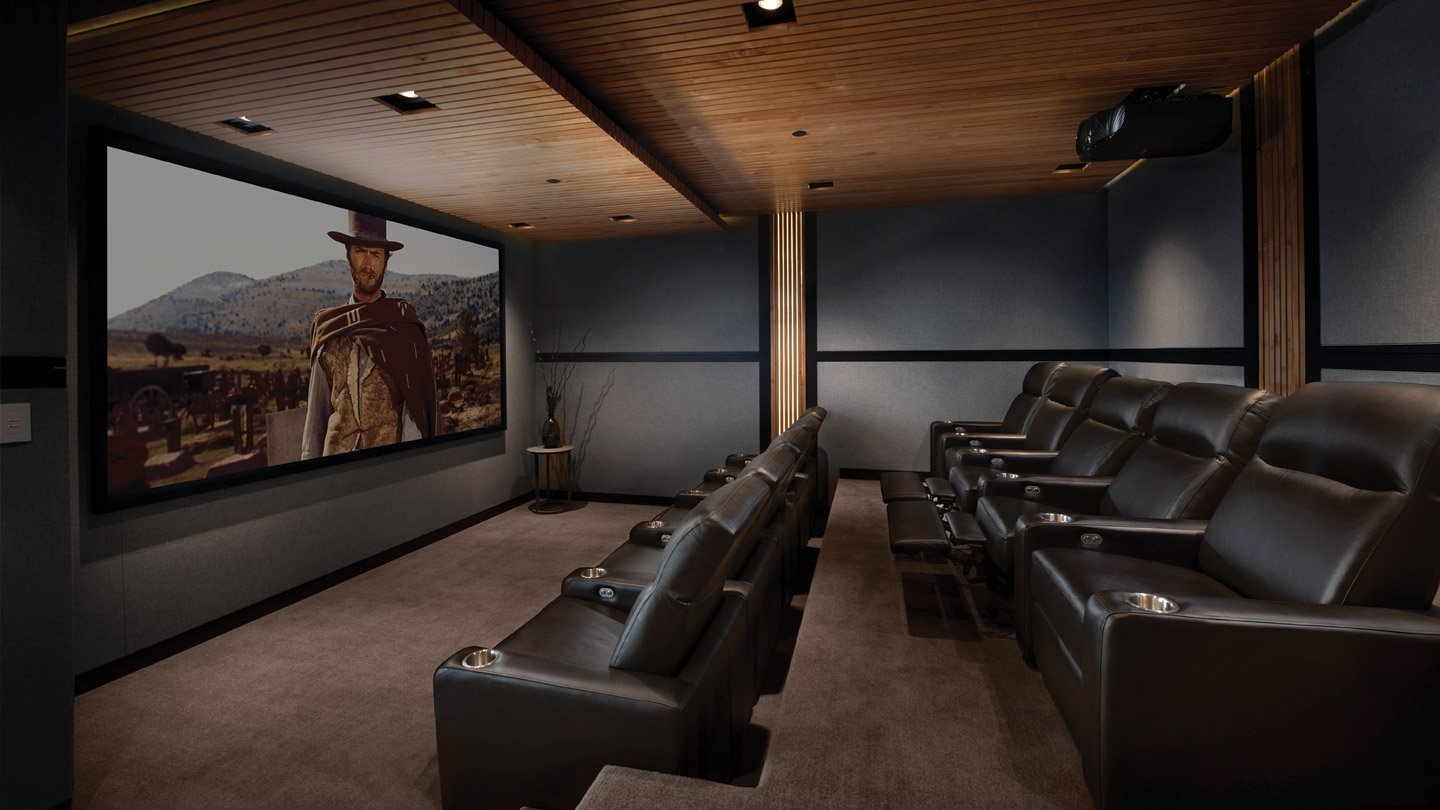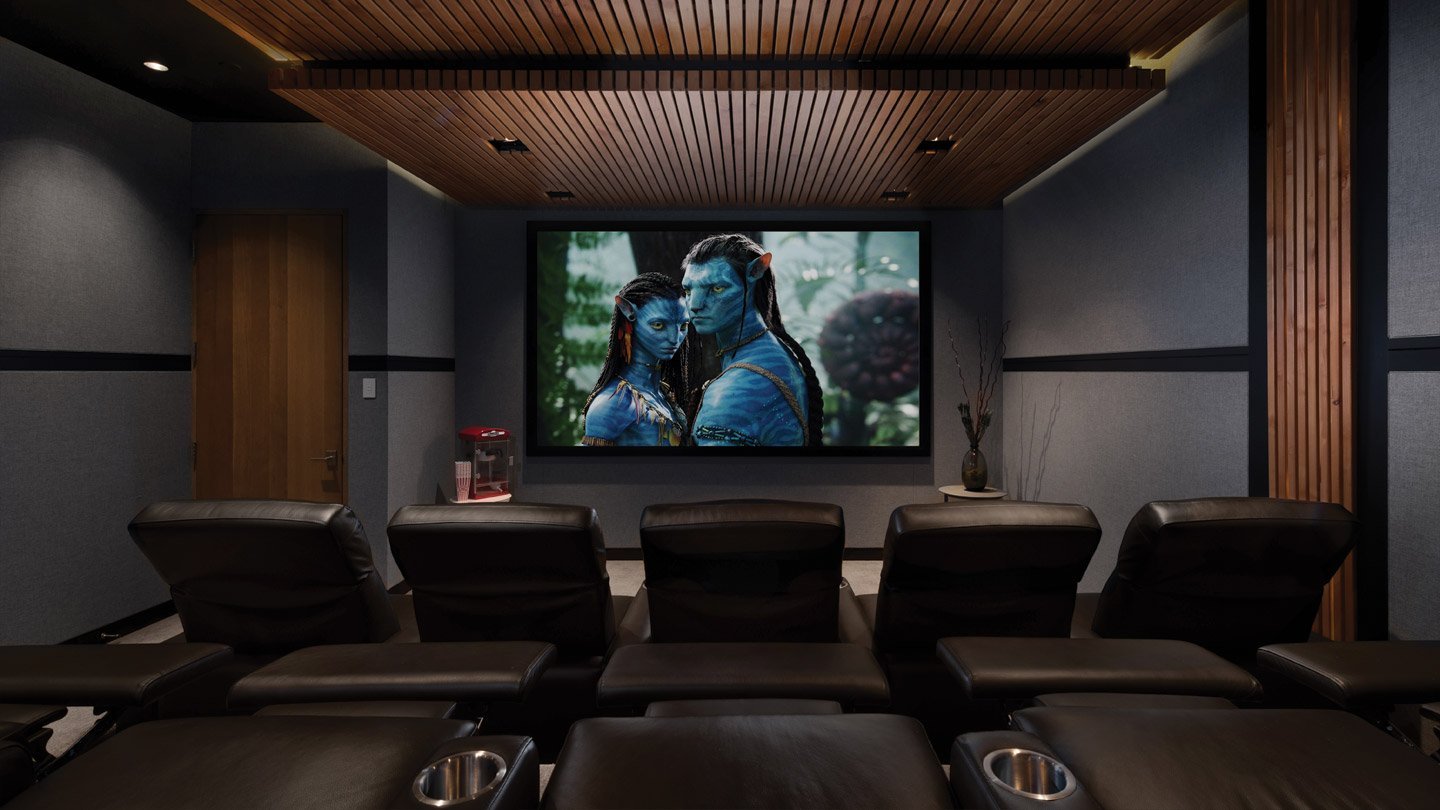
Home Theaters
Installing a home theater is a significant undertaking that results in many years of family enjoyment.
Context: Home theater technology has greatly improved over the last few years as it has become more accessible and convenient to watch blockbuster movies in the comfort of one’s home. Just as technology is improving, so too are the wired and wireless networks that do the heavy lifting of automation, and so home theaters are evolving as part of a technological ecosystem that composes the whole structure, rather than just one room.
Home automation has been around for years, and more homeowners are opting for converting their homes into smart homes where everything from lighting control, shades and blinds, temperature control and home security are all controlled automatically with a simple press of a button or tap of a touchscreen. And home automation can now be used for your home theater, giving you and your family an enhanced, stress-free movie viewing experience.
The modern home theater should be simple, intuitive, powerful & comfortable. It should be this way not because that’s what everyone has, but because it isn’t what everyone has - this is the optimal state, but not everyone will get there. That said, if you want a truly innovative luxury technology system in your home, you know not to settle for less than the best. All that said, choosing the right features is of paramount importance, and it’s difficult to do so if you or your team doesn’t know it’s way around a particular category or products. Does my client need a Crestron Home system? Do they want Steinway Lyngdorf speakers, or JBL Synthesis? Do I even know a Crestron dealer in Montana? Will the client want switchable smart glass in the windows for a media-room style build, or will they want blackout drapes, or even automatic blinds? If you have these questions, you’re already headed in the right direction.
Challenge: Creating a home theater that lives up to your dreams comes with a range of challenges and considerations. First and foremost, one must have the appropriate space, and one must have enough space. Then, the natural next question becomes “who will be the primary users?” And then, “what is the intended purpose? Is this a home theater, a media room, or something that blends the purpose of a large display and surround sound?” The questions can go on and on, but the most important thing is usually to analyze the house plans and dedicate a room to this sort of technology. Then, the challenges tend to line up as they are contextualized. Synchronizing the design of the room with the architects, builders and other designers involved used to be something that was outside the purview of low-voltage contractors. This is slowly changing as the aforementioned parties realize that there has been a distinct shift in how essential home integrators have become in the eyes of the client - if the client wants a home technology system, a technology specialist must be part of the conversation - ideally from the get-go. That doesn’t mean that that technologist should take precedence over others, however, and SAV believes that a collaborative approach where everyone is on the same page is important so that the client gains the best outcome. Case in point, the collaborations’ success often lies in allowing others to inform each other of their parameters and best outcomes up front, so that the goal is clear from the get-go.
On one such project, we collaborated with EK Reedy, and due to their expertise, we all were able to have a more fruitful outcome.
“There are several important design elements one should consider upon designing their home theater and media rooms—what I refer to as the ‘Fabulous Five.’” – Katherine Reedy, EK Reedy Design
More of her words were paraphrased and adapted below, and you can read the original article here.
1. How and Whom
Once the client has decided how they want to use their media room, it will become clear how they want to approach the design. Private screening for two or an elaborate second living room for the extended family? How many will usually use the space, and how many could comfortably use the space on other occasions?
2. Shape and Size
Once one knows their viewing needs, the space can then be defined. A rectangular deep space is preferred for sound distribution, but if you are looking to incorporate large plush sofas and a bar area, a square space would be more workable. Screen sizes can vary, but we like seating to be a minimum of 9 feet from the big screen, with the center of the screen at eye level while sitting.
3. Lighting
Smart lighting sets the stage for the home theater. It can create a grand entrance or a quiet walkway. We like to address a home theater space with multiple lighting levels -- one level that provides general lighting through the application of concealed light sources in the ceiling and a secondary level introducing low-wall lights for pathways.
4. Acoustics
Having an A/V specialist on your team is a must. They will specify the appropriate equipment and speakers based upon the design of the media room. The room itself can even be designed with acoustics in mind, if the A/V firm is involved from the beginning.
5. Color
Neutral, gray and earth tones work nicely and do not interfere with the colors being projected from the big screen. Warm amber glows make for a soft transition to the eyes, when the lights go back up.
All of these considerations are important, but not something that the client should have to worry about - the planning team, including the A/V specialists, should take on the heavy lifting of optimizing the design for the client so that their needs and wants are all met.
Solutions: How Automation Enhances Your Home Theater
Temperature and Climate Control
Home automation controls the temperature inside your home, making it comfortable and more energy efficient. Many home automation climate control systems can be controlled using a remote so you don’t have to make your way to the thermostat. No more freezing in the movie theater or packing the mandatory ‘movie sweater.’ You get to set your temperature to your preference, because it’s your home theater.
Lighting Control
In movie theaters, properly-timed lighting is crucial. Lights are needed before and after the movie to allow guests to navigate their way out of the theater. It is equally crucial that the lights are turned out during the movie to make the experience enjoyable and captivating. With a home theater that is controlled by automated lighting, you can brighten and dim the lights with a simple press of the button - on the wall, on your remote, on your phone - or even have the lights go on and off automatically. A proper control system, such as Crestron Home System, can streamline your home theater by integrating all controls into a single interface.
The ability to control the lighting in your home allows for increased convenience, enhanced safety and moderately improved electrical efficiency.
Surround Sound Control
Speakers are an important component of a home theater system. Strategically placing high-quality speakers and tuning them to create a perfect zone will give you and your family the feeling of being in the movie, not just in front of it.
Setting up speakers, however, can be tricky - especially if you have several distinct audio zones. High-quality speakers with more complex settings and abilities are ideal for a home theater, which can provide a challenge even for AV experts. Setting these up properly and fully using them correctly and fully taking advantage of all they have to offer can be frustrating to figure out.
With an automated home theater system, the technologically advanced components can be easily set up and the settings saved so all you need to do is simply press a button or two on a remote and the speakers will work properly in sync with each other every time, giving you the ideal surround sound experience.
Projector and Ultra 4K TV
In order to fully appreciate a movie within a home theater, the display is all important. Not just any screen will do. There is a reason people pay to go to a theater - it enhances the experience in part by showing you a movie that is larger than life on a display that matches.
With the increased popularity of home theaters, TVs, projectors and movie players get more and more technologically sophisticated. The thick, bulky TVs of the past with the equally ponderous DVD player are no longer fit for use in the modern theater, home or otherwise. Large, flat-screen TVs with 4K ultra HD picture quality, with small wireless movie players such as Kaleidescape’s Strato Movie Player, are now the new home theater standard.
With the advancement in technology, one can play movies from their nearly limitless online cloud movie storage. No more unsightly racks of DVD movie cases. The new way of watching movies online allows people to watch their favorite movie wherever they want with superb image quality.
Smart TVs can play your favorite movie by downloading it from the Internet, or via cloud storage access and streaming. With a few clicks of your TV remote, you can watch and record your favorite TV shows, watch YouTube videos and enjoy a family movie night.
For those with large home theaters that can accommodate a movie screen and projector, you’d be happy to know that home automation can make setting up the projector and the automatic opening up and turning up the screen quick, easily and convenient. A few buttons on a remote enables you to automatically play and stop the projector as well as roll up and down the blank movie screen.
An automated home theater will not only give you and your family unforgettable movie nights, but also carries additional benefits including increasing your home’s resale value, additional level of security, and make your home the ultimate entertainment spot on the block.
Whether it’s your first attempt at a home theater or you’ve moved into a new home and would like to install another home theater, using home automation will enhance the home movie viewing experience and remove the stress and frustration of equipment not working properly or being ill-timed.
Results:
Theater A: SAV applied its top-tier product selections to this home theater: A 4K projector accompanied by a 105” fixed acoustically transparent screen, an in-wall 7.2 surround sound system hidden behind professionally designed and engineered acoustic panels, advanced electronic power, energy and thermal management, the latest in automated lighting, climate, and audio/video control, and last but not least - black leather, automated incline, theater-style seating with ratcheting headrests.
Tech Features:
Projection System:
Sony VPL-VW1100ES 4K 3D Projector
Stewart Filmscreen 105" 2.35:1 Cinemascope Perf Screen Fixed
7.2 Professional Surround Sound by JBL Synthesis (In-wall, hidden):
JBL Synthesis Four (LCR) S4HC, S4VC
JBL Synthesis Four Surrounds (4) S4Ai
JBL In-wall Dual 10” subwoofer (x2)
Surround Sound Processing and Amplification:
JBL Synthesis and SDEC 3000
JBL Amplification with Panamax
JBL Professional in-home calibration
Audio/Video Sources:
Local Sources: Gaming inputs for Wii and Xbox
Central Sources: AppleTV, Kaleidescape Blu-ray, DirecTV System
Control:
Full Savant Control and Integration
Lutron Lighting Control System
Power management:
Advanced electronics power, energy and thermal management
Theater Interior:
CinemaTech engineered acoustic room treatment and wall finishes professionally designed, engineered, and installed.
Theater board on upper ceiling.
Theater Seating:
CinemaTech professionally designed theater seating (2 rows of 5 seats) black leather with automated incline and ratcheting headrest.
Theater B: Home of the Year Award 2021
Working closely with the clients, Montana Expressions Interior Design, and Journey & Sons Contractors, SAV Digital Environments was able to help create a home theater and lounge space for the couple, reflecting their present-day style while keeping the traditional "ranch feel" design elements and build intact. It was a highly collaborative effort and could not have turned out any better.
“We had a great experience working with the SAV team! Everyone that we worked with throughout the design and build process were very passionate about the project, and you know when the A/V team is over-the-top excited about the result, it’s a good one. The sound quality is top notch, the visual is first-rate, and overall aesthetics of the space is superb. We could not be happier with the completed project.” — Chris M., Client
Tech Features:
Dolby Atmos 9.2.4 Home Theater
JBL Synthesis SDR-35 Professional 16-channel media receiver with 7-channel amplification
JBL Synthesis high-performance cinema-grade SC-4 and SC-5 in-wall/ceiling loudspeakers
JBL Synthesis SSW-2 dual 12” in-cabinet subwoofers w/ Crown Audio CDi 2-1200 watt sub amp
JBL/Lexicon DD8 8x125 multi-channel amplification for Atmos and surround back speakers
Sony 4k Projector VPL695ES
4k Video Balun set with for projector and an Aux input for local AV Source
Screen Innovations 10' acoustically transparent 16:9 fixed wall mounted Series 5 screen
Control4 Neeo touch-screen remote and central processor
Panamax M5400-PM Power Management w/ Voltage Regulation
McIntosh MT5 Turntable w/ McIntosh MP100 Preamplifier
McIntosh Analog Cabling with connection to new Crestron Audio Extender to theater system
Sonos distribution for whole home audio system
Sonance DSP Amplifiers for increased audio experience through rest of home
Theater C: Steinway Lyngdorf 9.6 surround sound home theater
Not only did the design and architecture match the aesthetics of the rest of the ranch, reminding us of our home here in Montana, the integrated system and design treatments were completely aligned with the architectural intent and interior design of the residence.
In keeping with the Steinway & Sons legacy for quality and perfection, this theater's Steinway Lyngdorf surround sound is completely genuine, maintaining a closed system ensuring the quality of the audio, a purity of sound that enables us to promise perfection in delivery. Using an intelligent system called RoomPerfect™, which not only identifies the characteristics of the sound of the speakers, but also requires specific measurements of the room acoustics, it applies corrections to the signal over a process that leaves the room with sound that’s perfectly adapted for the shape, size, and acoustic properties.
Tech Features:
Steinway Lyngdorf 9.6 surround sound home theater
in-wall Model M speakers
Model LS boundary subwoofers
Model A1 amplifier
Model P200 surround sound processor
130" Stewart Filmscreen CineCurve Vertical Masking Screenwall
Sony 4K home cinema projector
CinemaTech acoustics wall treatments
Valentino motorized incliners








